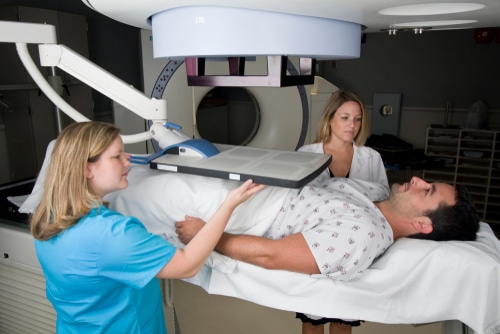Radiation Therapy for Mesothelioma Treatment

Radiation therapy uses ionizing radiation, primarily in two forms:
- Photon Beam Radiation: Similar to X-rays but at higher doses, it can shrink tumors but risk damaging healthy tissue.
- Particle Radiation: Using electrons or protons, it delivers energy precisely to cancer cells, minimizing collateral damage. However, proton radiation is limited in availability.
Radiation specialists consider these properties when designing treatment. Radiation therapy may extend life expectancy for some mesothelioma patients.
Benefits of Radiation for Pleural Mesothelioma
Radiation therapy provides several benefits:
- Survival Extension: Combining radiation with other therapies is linked to better mesothelioma outcomes.
- Improved Quality of Life: It can manage symptoms and reduce the need for potentially detrimental surgeries.
- Symptom Reduction: Radiation alleviates specific cancer symptoms.
- Tumor Shrinkage: It can make tumor removal easier for surgeons.
- Immune Stimulation: Radiation may enhance the immune system’s cancer-fighting abilities.
Patients should discuss radiation’s benefits and risks with their oncologists to tailor treatment to their unique needs.
How Radiation Works
Radiation therapy damages mesothelioma cell DNA, causing cell death and inhibiting replication. Fast-growing cells are more affected, while slower-growing ones take longer to perish.
Radiation therapy has shown the most promise in pleural mesothelioma cases, but it has limited effectiveness in peritoneal mesothelioma.
Radiation as Part of Multimodal Mesothelioma Therapy
Doctors often combine radiation therapy with surgery and chemotherapy, enhancing survival rates.
Palliative Radiation Therapy
Palliative radiation helps relieve symptoms in advanced stages, such as pain and breathing difficulties caused by tumor pressure on vital organs.
Types of Radiation Therapy
Radiation therapy can be internal or external. External beam radiation therapy (EBRT) uses intense radiation beams guided by computers, with techniques like 3-D conformal radiation therapy (3DCRT) and intensity-modulated radiation therapy (IMRT) improving precision.
Stereotactic body radiation therapy (SBRT) delivers high radiation doses in fewer sessions, while internal radiation therapy (brachytherapy) uses implants to target cancer locally.
Radiation Procedure and Experience
Radiation treatment frequency and duration vary based on factors like location, radiation type, and cancer stage. Recovery may involve fatigue and other side effects that patients should discuss with their healthcare team.
Survival
Survival after radiation depends on factors like cell type, overall health, cancer stage, and treatment type. Outcomes vary, with pleural mesothelioma patients generally experiencing longer survival.
Side Effects
Radiation therapy can cause localized side effects like fatigue, hair loss, mouth problems, and skin issues. These should be reported to physicians for appropriate management.
Eligibility
Eligibility for mesothelioma radiation therapy considers factors like cancer stage, overall health, and tumor location. Experienced oncologists assess these factors to recommend suitable radiation options. Patients should consult specialists to understand potential benefits and risks associated with radiation treatment.
